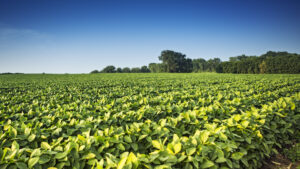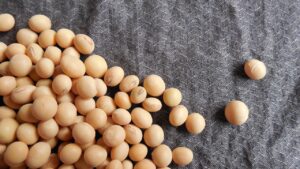In preparation for planting African evaluation trials, Kristin Bilyeu works to increase 200 soybean lines under the Mississippi sun. Developing adaptable high yielding varieties for the low-latitude tropics is difficult, yet that’s exactly what Bilyeu, a research molecular biologist for the U.S. Department of Agriculture, and her team have set out to accomplish.
One of their goals is to develop varieties adapted to Ghana and Mozambique. Add to that the desire to incorporate low-processing traits into varieties while creating seeds visually distinct for use at the household level, and that’s quite the challenge. These efforts, a part of the Missouri-based Soybean Innovation Lab, build upon previously identified methods for removal of trypsin inhibitors and lectin, respectively KTI and Le, the two factors that require heat processing for utilization.
Reducing the heat required for meal preparation could benefit villages, due to less reliance upon cooking fires. Exposure to physical danger may be reduced for those engaged in fuel gathering activities, as fewer combustibles are needed to stoke cooking fires. And time previously devoted to these activities can be otherwise invested.
The term “low-processing” means different things among those having dissimilar life experiences. In the context of a highly industrialized and commercialized soybean industry, one might identify closely with the processing that occurs post-harvest. But in the context of subsistence farming, household processing may take a more holistic view.
For example, Juan Andrade cites ease of harvest and shelling, plus activities related to seed storage, as all being processes. The more efficient the process, the lower the processing requirement, explains the University of Illinois assistant professor of food science and human nutrition. Andrade also serves as the U.S. Feed the Future’s Soybean Innovation Lab principal investigator of utilization for human nutrition.
In large-scale commercial processing, the soy oil and meal components are typically separated either by solvent extraction or mechanical extrusion processes. In comparison, varieties requiring less complicated and costly processes can be performed at the household level.
In the context of small-scale home or village-level soybean utilization, “low-processing” might well encompass the full range of production practices providing labor or other resources are conserved. “Low-processing,” by yet another definition.
Opportunity in Soy
As one of the few plant-based sources of high-quality protein, soy has great nutritional and financial benefits for smallholder farmers. However, in the eyes of the hungry, availability and quantity generally prevail over nutritional value. “Eating full fulfills a basic need,” Andrade says.
Furthermore, many smallholders lack basic knowledge of small-scale soy processing and how to incorporate protein-rich soy ingredients into their diets.
The Soybean Innovation Lab provides intensive and interactive village-level trainings focused on soy processing, nutrition and integration into local cuisines. This equips smallholder farmers with the skills to process soybeans using tools they already have with minimal energy inputs.
To an extent, householder’s experience reduced demands on their time and physical labor, resulting from use of new technologies. However, failure to introduce productive and healthy activities into those time voids may result in unintended consequences.
What range of options become available to those relieved of drudgery tasks? Will it provide short-term gratification or long-term benefit? Choices that simply lead to adoption of less active lifestyles, increased reliance upon diet staples or lower intake of vitamins and minerals may lead to other societal problems.
Andrade reminds that sedentary lifestyles are known for making people prone to developing diabetes. “We have low-cost cures for diarrhea, but we have no cure for diabetes, and treatment costs remain very high,” he says.
This begets the question, how might time and energy conserved as result of technology adoption best be invested?
New technologies must first be envisioned, then developed, later introduced and adopted. Wise utilization is required to bring about the greatest benefit. To that end, be aware of a potential catch-22.












